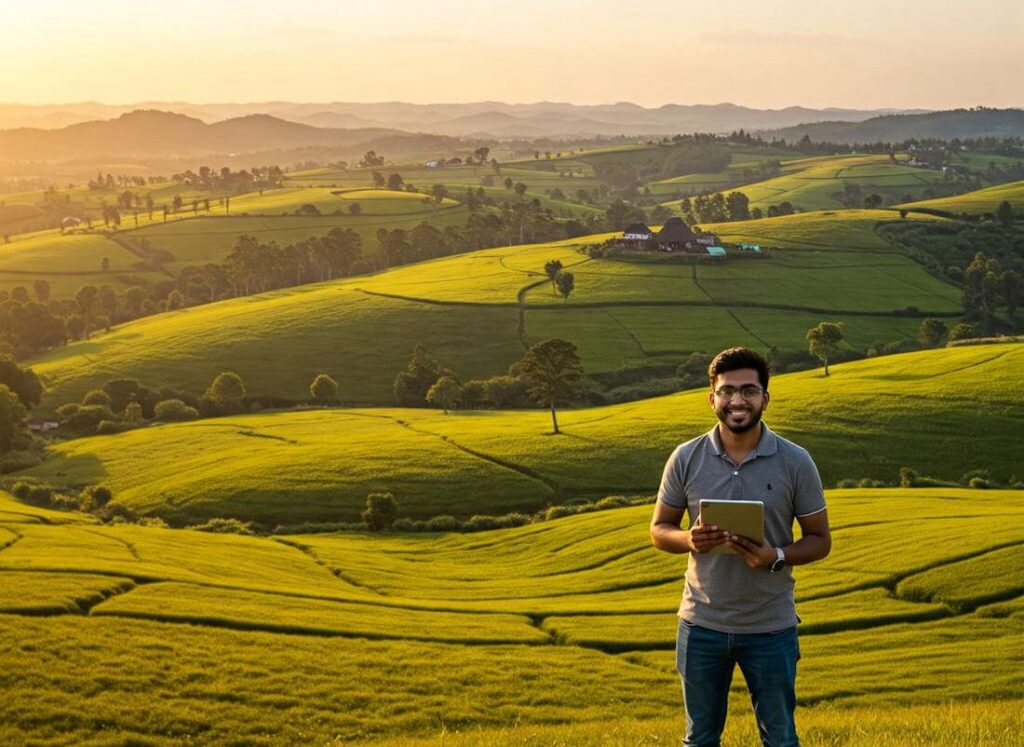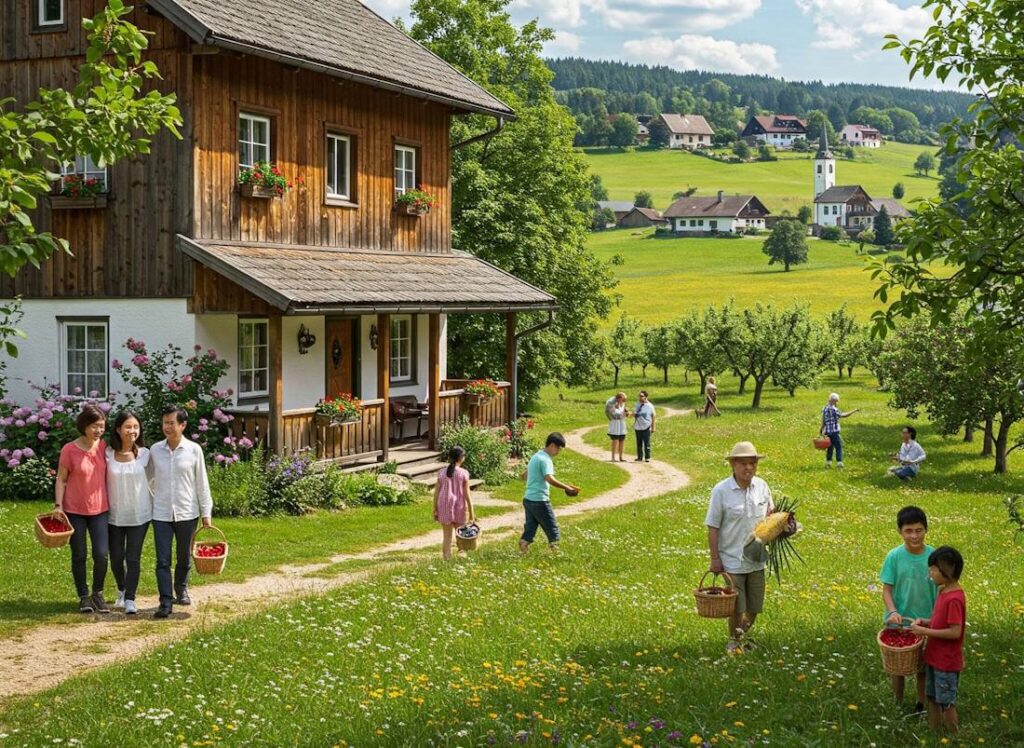Rural tourism has emerged as a distinctive segment within the broader tourism industry, focusing on the attractions, experiences, and activities available in less populated, countryside areas. This form of tourism provides an opportunity for visitors to connect with nature, immerse themselves in local culture, and experience an authentic lifestyle that differs significantly from urban tourism. Unique characteristics of rural tourism include its emphasis on sustainability, community engagement, and the promotion of regional heritage and customs.
One of the primary benefits of rural tourism is its capacity to contribute to local economies. By attracting visitors, rural areas can benefit from increased spending on accommodations, food, and local artisan products. This influx of economic activity helps sustain not only local businesses but also supports vital services that may otherwise be marginalized or at risk in less populated regions. Consequently, a thriving rural tourism sector enhances the resilience of local communities, preserving traditional crafts, agricultural practices, and natural landscapes.
Moreover, there is a growing trend among consumers seeking authentic, nature-based experiences away from the hustle and bustle of city life. This shift in consumer preference highlights a demand for more personal and hands-on experiences, such as farm stays, eco-tourism, and cultural festivals that showcase local traditions. As urban dwellers increasingly seek refuge in serene environments, the promotion of rural tourism becomes essential for maximizing the potential of these areas. Engaging with local communities and embracing their unique cultures not only enriches guest experiences but also fosters a sense of pride among residents.
In conclusion, understanding rural tourism is pivotal for those looking to promote their businesses online. By recognizing its characteristics and benefits, stakeholders can effectively attract visitors while making significant contributions to their local economies.
Identifying Your Target Audience
Understanding your target audience is a crucial component in promoting your rural tourism business effectively. By identifying the specific demographics and preferences of potential visitors, you can tailor your marketing strategies to align with the interests and needs of those who are most likely to engage with your offerings. Begin by considering various demographic factors such as age, income level, interests, and travel habits.
For instance, younger travelers may seek adventure and unique experiences, while older audiences might prioritize comfort and convenience. Conduct a thorough analysis of your potential customers by segmenting them into groups based on these characteristics. This process can help you identify niches within the rural tourism market that are underserved or present growth opportunities.
In addition to age, consider interests that may influence travel choices. Nature lovers might be drawn to activities such as hiking, birdwatching, or eco-tours, while families may be interested in recreational activities suitable for children. Understanding these preferences can inform the design of tailored packages or activities that resonate with your audience.
Market research is a valuable tool in deciphering the desires of your target demographic. Utilize surveys, social media polls, and analytics from your website and social channels to gain insights into the interests and behaviors of visitors. Engaging in conversations with past customers can also provide feedback on what attracted them to your rural tourism offerings, helping you shape future marketing efforts. By leveraging this research, you can craft targeted messaging that not only reaches but also resonates with your audience, ultimately driving engagement and increasing profitability for your rural tourism business.
Building a Strong Online Presence
Establishing a strong online presence is crucial for any rural tourism business aiming to attract visitors and increase profitability. The first step in creating this presence is developing a user-friendly website that resonates with potential travelers. This website should effectively capture the essence of the rural tourism experience you offer, showcasing stunning landscape images, local attractions, and unique accommodations that highlight the charm of the area. High-quality visuals are essential; they serve as the first impression and can greatly influence a visitor’s decision to engage with your business.
Beyond aesthetics, engaging content also plays a critical role in the user experience. This includes informative blog posts, detailed descriptions of services and experiences offered, and customer testimonials that bring authenticity to your business. By addressing visitors’ questions and providing valuable insights into the rural environment, such content fosters a connection with potential customers. Furthermore, integrating local culture and history into your content can enhance its appeal and make your business stand out in a crowded market.
In addition to focusing on design and content, optimizing your website for search engines (SEO) is vital for increasing visibility online. This can be achieved by incorporating relevant keywords associated with rural tourism throughout the website, including in headings, meta descriptions, and image alt tags. It is equally important to ensure that the site is mobile-responsive, allowing easy access for users on various devices. By maximizing both user experience and search engine visibility, rural tourism businesses can effectively attract more visitors and, ultimately, increase profits.
Leveraging Social Media Marketing
In the realm of rural tourism, social media marketing serves as a powerful tool to promote businesses effectively. With various platforms catering to diverse demographics, identifying the right channels for your target audience is crucial. For instance, platforms such as Instagram and Pinterest, with their visual-centric nature, are particularly effective for showcasing stunning landscapes, local culture, and unique experiences that rural tourism offers. Meanwhile, Facebook can be utilized for community building and event promotion, allowing businesses to connect with potential customers on a more personal level.
To harness the power of social media effectively, creating engaging content is paramount. Storytelling can be a compelling method to attract interest, as it allows potential visitors to envision their experiences in your rural setting. Sharing personal stories about the community, local traditions, or your journey as a rural tourism entrepreneur can create a deep emotional connection with your audience. User-generated content is another excellent strategy; encouraging visitors to share their experiences through photos and reviews not only enhances your credibility but also fosters a sense of community among followers. Reposting these stories also shows appreciation for your visitors while promoting the authentic experiences your business offers.
In addition, utilizing relevant hashtags can significantly expand your reach on social media platforms. Research popular hashtags within the rural tourism niche, or create a unique one representing your brand. This practice will make it easier for potential clients to discover your offerings and engage with your content. Consistent interaction with your followers, whether through comments, messages, or engaging posts, helps build a loyal community around your brand. This sense of community can convert followers into actual guests, effectively increasing your rural tourism business’s profitability and visibility online.
Utilizing Online Travel Agencies (OTAs)
In the evolving landscape of rural tourism, partnering with Online Travel Agencies (OTAs) has emerged as a pivotal strategy for increasing visibility and enhancing bookings. OTAs act as intermediaries between travelers and businesses, allowing rural tourism operators to reach a wider audience than would typically be possible. By leveraging OTAs, businesses can capitalize on the extensive networks and marketing expertise these platforms offer, thus gaining access to a larger pool of potential customers.
One significant advantage of utilizing OTAs is the boost in visibility that comes with being featured on well-known platforms like Booking.com, Expedia, or Airbnb. These sites attract millions of users daily, providing rural tourism businesses with an immediate opportunity for exposure. Enhanced visibility not only facilitates increased booking rates but also fosters brand recognition in a crowded marketplace, essential for driving repeat business.
When selecting the right OTAs, it is crucial for businesses to consider factors such as target demographics, commission rates, and the specific markets each OTA serves. Businesses should evaluate which platforms align best with their offerings and target customers. Moreover, it is equally important to optimize listings to maximize potential exposure. This may include using high-quality images, writing engaging descriptions, and incorporating strategic keywords that reflect the unique aspects of the rural experience offered.
Metadata, such as accurate location tags and amenities, should be meticulously included to enhance searchability. Additionally, actively managing responses to customer reviews can build trust and credibility, further amplifying the appeal of listings. By strategically utilizing OTAs, rural tourism businesses can effectively navigate the digital marketplace, leading to increased profitability and a more robust online presence.
Creating Engaging Content and Promotions
In today’s digital landscape, creating engaging content is crucial for promoting your rural tourism business online and attracting potential visitors. Content marketing strategies can significantly enhance visibility and engage an audience interested in unique experiences. One effective method is to develop informative and captivating blog posts that showcase the distinctive features of your rural offerings. These posts can highlight local attractions, cultural insights, and activities that reflect the authentic rural experience, drawing in readers seeking memorable adventures.
In addition to blog posts, consider incorporating various content formats to cater to different audience preferences. For example, videos can provide a dynamic glimpse into the activities and scenery your rural tourism business offers. Short, engaging clips showcasing breathtaking landscapes, local festivities, testimonies from satisfied customers, or guided tours can offer potential visitors a taste of what to expect, fostering a connection with your brand. Additionally, infographics summarizing key information in a visually appealing manner can be a valuable tool for quickly conveying enticing details about your offerings.
Email newsletters represent another effective medium for keeping your audience engaged. These can feature content such as latest updates, upcoming events, special offers, and inspiring stories or testimonials from visitors. Regular communication through newsletters helps build a community around your rural tourism brand while encouraging potential travelers to return for the latest offerings and promotions.
When it comes to promotions, crafting attractive packages is essential. Consider offering group discounts, seasonal deals, or special event packages that bundle experiences together. These promotions can entice visitors to book their trips while experiencing the best of what your rural tourism business provides. By blending engaging content with well-thought-out promotions, you can effectively increase interest and ultimately drive profits for your business.
Harnessing Email Marketing
In the digital age, email marketing stands out as a crucial component for promoting your rural tourism business. By establishing a robust email list, you can maintain a direct line of communication with potential visitors, ensuring they are consistently informed about new offers and events. An effective email marketing strategy not only nurtures existing relationships but also attracts new customers. It is essential to gather email addresses from interested parties, ideally through your website, social media platforms, and during local festivals or events.
Once your email list is compiled, segmenting your audience becomes paramount. Different visitor profiles may have varied interests and preferences, and tailoring your communications accordingly enhances engagement. For instance, families might appreciate promotions on kid-friendly activities, while adventure seekers might be attracted to outdoor excursions. By categorizing your audience based on criteria such as interests, past visits, or demographics, you enable yourself to craft messages that resonate on a personal level, which is vital in building loyalty and driving repeat visits.
Creating personalized emails is the next step in this process. Engaging newsletters, timely announcements, and attractive promotions can spark interest and encourage bookings. Ensure your emails have appealing designs that mirror the aesthetic of your rural tourism business. Use vivid imagery and concise text to capture the essence of your offerings. Incorporating calls to action, such as booking links or social share buttons, can greatly enhance your email’s effectiveness. Additionally, analyzing the performance of your campaigns through metrics like open rates and click rates will provide valuable insights. This information will guide future content and help optimize your email marketing efforts.
Gathering and Showcasing Customer Reviews
Customer reviews and testimonials play a critical role in promoting any business, particularly in the rural tourism sector. Potential guests heavily rely on the experiences of previous visitors when deciding on their accommodations and activities. Positive reviews can enhance credibility, build trust, and ultimately lead to increased bookings and revenue for your rural tourism business. Therefore, actively gathering and showcasing these reviews is essential for driving growth.
To encourage satisfied visitors to leave positive reviews, it is essential to create a memorable experience during their stay. High-quality service, unique experiences, and attention to detail can significantly motivate guests to share their thoughts. Following up with customers post-visit through email or social media can also be effective. Sending a friendly message thanking them for their stay and gently prompting them to share their experiences can yield positive results. Furthermore, offering incentives such as discounts on future stays can encourage guests to leave feedback, which can be beneficial for your promotional efforts.
When it comes to showcasing customer testimonials, several strategies can be utilized to maximize their reach and impact. Displaying reviews prominently on your website, especially on landing pages, can significantly influence potential customers. Creating a dedicated testimonial section or integrating customer feedback within blogs or service descriptions can also enhance visibility. Additionally, sharing positive reviews on social media platforms can amplify your reach, as these platforms allow for the sharing and resharing of content, potentially reaching a broader audience.
Addressing negative feedback constructively is equally important. Providing thoughtful responses to negative reviews shows that you value customer opinions and are willing to improve. This can turn a dissatisfied customer into a loyal one if addressed appropriately. By managing both positive and negative feedback responsibly, you can build a strong online reputation, further promoting your rural tourism business.
Analyzing Performance and Adjusting Strategies
In the competitive landscape of rural tourism, the continuous evaluation of marketing performance is essential for sustaining growth and ensuring profitability. Tracking and analyzing key performance indicators (KPIs) helps businesses understand consumer behaviors and preferences, which can significantly influence marketing strategies. Tools such as Google Analytics provide invaluable insights into website traffic, engagement metrics, and conversion rates, allowing rural tourism businesses to make data-informed decisions.
Utilizing Google Analytics, businesses can monitor various aspects of their online presence, including the number of visitors, duration of visits, and the behavior flow of users navigating through the website. This data enables business owners to identify which pages are most attractive to potential customers and which marketing channels yield the highest returns. Additionally, understanding user demographics and geographical distribution can help tailor marketing messages to resonate more with the target audience.
Furthermore, assessing conversion rates is a crucial part of the performance analysis. Understanding how many visitors turn into customers provides insights into the effectiveness of current strategies. If conversion rates are lower than expected, it may signify a need for adjustments in the user experience, content quality, or even the promotional tactics employed. Regularly reviewing these metrics fosters a proactive approach, allowing for timely modifications to marketing tactics based on empirical evidence.
Beyond just tracking, it is important for rural tourism businesses to cultivate a culture of continual assessment. This means not just analyzing data on a one-off basis but setting up a regular schedule for review and adaptation of strategies. Such disciplined analysis can lead to ongoing optimizations in results, ensuring that marketing initiatives remain relevant and effective in reaching potential customers while leveraging the unique appeal of rural tourism offerings.



